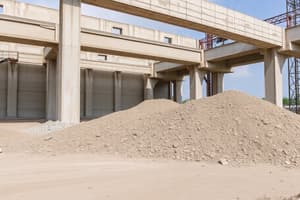Podcast
Questions and Answers
What represents the best available estimate of the actual member strength in reinforced concrete structures?
What represents the best available estimate of the actual member strength in reinforced concrete structures?
- Maximum strength of materials
- Yield strength of steel
- Design based on nominal strength (correct)
- Serviceability limit conditions
Under what conditions do concrete and steel typically reach their maximum strength?
Under what conditions do concrete and steel typically reach their maximum strength?
- Normal service loading
- Elastic range loads
- Compressive load only
- Near or at failure loads (correct)
What does the subscript 'n' signify when referring to the strength of a member?
What does the subscript 'n' signify when referring to the strength of a member?
- Nominal strength of the member (correct)
- Necessary strength of the member
- Newly defined strength of the member
- Net strength of the member
Which factor is NOT a consideration in the design of reinforced concrete members for serviceability?
Which factor is NOT a consideration in the design of reinforced concrete members for serviceability?
Why must the nominal strength of a member be based on inelastic behavior?
Why must the nominal strength of a member be based on inelastic behavior?
What characteristic of concrete occurs after reaching its maximum strength?
What characteristic of concrete occurs after reaching its maximum strength?
Which aspect of structural members is emphasized primarily during the design process?
Which aspect of structural members is emphasized primarily during the design process?
What is a crucial limit condition that must be controlled in service loading?
What is a crucial limit condition that must be controlled in service loading?
What must be considered due to variations in dimensions and material properties in design?
What must be considered due to variations in dimensions and material properties in design?
What happens to steel when it is stressed beyond its elastic domain?
What happens to steel when it is stressed beyond its elastic domain?
Flashcards are hidden until you start studying
Study Notes
Authors and Edition
- The book is authored by David Darwin, Charles W. Dolan, and Arthur H. Nilson, with expertise in civil engineering and concrete structures.
- This is the fifteenth edition, published by McGraw-Hill Education in 2016.
Concrete Mix Composition
- Concrete consists mainly of fine and coarse aggregates, cement, and water.
- Proper proportions are crucial; excess water is needed for workability but can impact strength.
- Special cements, aggregates, and admixtures can alter concrete properties for specific applications.
Curing and Quality Control
- Curing is essential to control moisture and temperature post-placement, affecting the concrete's final properties.
- High supervision and skill are required from mixing to curing to ensure quality and avoid substandard outcomes.
Historical Context and Versatility
- Concrete has been used for thousands of years, originating from lime mortars in ancient civilizations (12,000 to 6,000 BCE).
- Reinforced concrete merges benefits of concrete's compressive strength with the tensile strength of steel, resulting in diverse uses in construction.
Strength Variability
- Advanced materials available can yield significantly higher strengths (3-5 times) than typical concretes and steels.
- High strength allows for smaller cross-sectional areas, reduced dead loads, and longer spans.
Structural Design Considerations
- High strength materials can lead to large deformations and deflections under stress, necessitating careful design.
- Structural analysis must account for nonlinear inelastic behavior of concrete and steel, especially near failure conditions.
Serviceability Limitations
- Designs must also adhere to serviceability limits, managing beam deflections and crack widths under normal loading conditions.
- The nominal strength (indicated with subscript "n") is an estimated value based on accepted analysis methods, reflecting possible deviations in actual strength due to material variations.
Examples of Concrete Structures
- The Dakota Dome, a multipurpose stadium, showcases concrete's durability and adaptability, transitioning from an inflatable roof to a concrete structure with a steel roof in 2001.
- Various architectural designs highlight concrete's flexibility in texture, color, and form, allowing for a broad range of structural applications.
Studying That Suits You
Use AI to generate personalized quizzes and flashcards to suit your learning preferences.





